ON STAGE AND PROFESSIONAL SOUND SYSTEM
System components
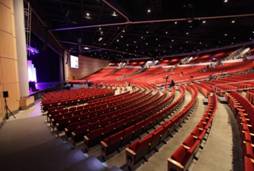
Input transducers
Many types of input with microphones being the most commonly used input device. They can be classified according to their method of transduction, pickup (or polar) pattern or their functional application. Most microphones used in sound reinforcement are either dynamic or condenser microphones.
Microphones used for sound reinforcement are positioned and mounted in many ways, including base-weighted upright stands, podium mounts, tie-clips, instrument mounts, and headset mounts.
Headset mounted and tie-clip mounted microphones are often used with wireless transmission to allow performers or speakers to move freely
Dynamic Microphones vs Condensor Microphones *****
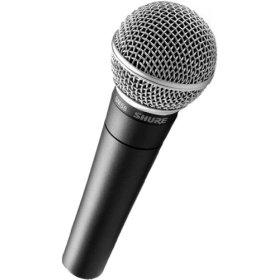
The Shure SM58 is a classic example of a dynamic microphone.
Which type of microphone is best has long been the subject of intense debate among audio professionals and enthusiasts alike. Today, we’ll tackle the age-old question and help you determine whether you ought to use a condenser or dynamic microphone. As you’ll soon discover, the answer isn’t always straightforward.
The Basics
Condenser microphones work by putting a balanced electrical charge across two metal plates. This creates an electrical field between them, and when one of the plates moves because of the sound vibrations in the air, the voltage attached to this field changes accordingly. The change in voltage is directly proportional to the change in sound. In order to create the initial charge, however, condenser microphones need a power source.
Dynamic microphones, on the other hand, work like backwards speakers. Instead of an electrically-created, variable magnetic field moving a speaker cone to create sound vibrations, the diaphragm in a dynamic mic moves in time with the sound pressure changes. It’s connected to a coil which then moves within a constant magnetic field. The coil moving through the field produces an electrical signal that directly corresponds to the sound waves that caused it. Because the magnetic field can be generated using a permanent magnet, this doesn’t necessarily require an external power source, although some higher-quality active dynamic microphones do make use of one.
Pros and Cons
The two different types of microphone each have different characteristics. As technology improves, however, manufacturers are coming closer to achieving parity in important areas.
External Power
As you saw, some microphones require external power supplies, which are usually provided by the switchboard or an internal battery. It’s important to select a microphone that matches your input equipment. Input equipment that provides so-called “phantom power” must be used with all condenser and certain dynamic microphones.
Durability
Another commonly touted difference between the two is that some dynamic microphones are a bit more hardy. This isn’t true across the board, however. An increasing number of modern condenser microphones use solid-state (no moving parts) technology that makes them every bit as rugged and robust as their dynamic counterparts. Generally, microphones designed for studio recording sacrifice robustness for higher sound quality.
Expense
Traditionally, condenser microphones were much more expensive than dynamic microphones, but the fact of the matter is that you get what you pay for. Condensers usually have better sound quality because they’re more responsive to a wider range of signals, but if you expect your microphones to take a lot of abuse, it’s best to just go with high-end dynamics so that you don’t pay as much replacing them.
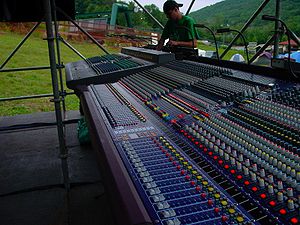
A Yamaha PM4000 and a Midas Heritage 3000 mixing console at the Front of House position at an outdoor concert.
Mixing Consoles
Mixing consoles are the heart of a sound reinforcement system. This is where the operator can mix, equalize and add effects to sound sources. Multiple consoles can be used for different applications in a single sound reinforcement system. The Front of House (FOH) mixing console must be located where the operator can see the action on stage and hear the output of the loudspeaker system. Some venues with permanently installed systems such as religious facilities and theaters place the mixing console within an enclosed booth but this approach is more common for broadcast and recording applications.

Large music productions often use a separate stage monitor mixing console which is dedicated to creating mixes for the performers’ on-stage or in-ear monitors. These consoles are typically placed at the side of the stage so that the operator can communicate with the performers on stage In cases where performers have to play at a venue that does not have a monitor engineer near the stage, the monitor mixing is done by the FOH engineer from the FOH console, which is located amongst the audience or at the back of the hall. This arrangement can be problematic because the performers end up having to request changes to the monitor mixes with “…hand signals and clever cryptic phrases”. The engineer also cannot hear the changes that he is applying to the monitors on stage, often resulting in a reduction of the quality of the mix.
Signal processors
Digital signal processors
Small PA systems for venues such as bars and clubs are now available with features that were formerly only available on professional-level equipment, such as digital reverb effects, graphic equalizers, and, in some models, feedback prevention circuits which electronically sense and prevent feedback “howls” before they become a problem. Digital effects units may offer multiple pre-set and variable reverb, echo and related effects. Digital loudspeaker management systems offer sound engineers digital delay, limiting, crossover functions, EQ filters, compression and other functions in a single rack-mountable unit. In previous decades, sound engineers typically had to transport a substantial number of rack-mounted analog devices to accomplish these tasks.
Equalizers
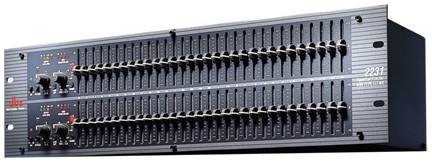
Equalizers exist in sound reinforcement systems in two forms: graphic and parametric. A high-pass (low-cut) and/or low-pass (high-cut) filter may also be included. Parametric equalizers are often built into each channel in mixing consoles and are also available as separate units. Parametric equalizers first became popular in the 1970s and have remained the program equalizer of choice for many engineers since then.
Graphic equalizers have faders (slide controls) which together resemble a frequency response curve plotted on a graph. Sound reinforcement systems typically use graphic equalizers with one-third octave frequency centers. These are typically used to equalize output signals going to the main loudspeaker system or the monitors on stage.
Compressors

Compressors are designed to manage the dynamic range of an audio signal. A compressor accomplishes this by reducing the gain of a signal that is above a defined level (threshold) by a defined amount (ratio). Without this gain reduction, a signal that gets, say 10% louder as an input, will be 10% louder at the output. With the gain reduced, a signal that gets 10% louder at the input will be perhaps 3% louder at the output. Most compressors available are designed to allow the operator to select a ratio within a range typically between 1:1 and 20:1, with some allowing settings of up to ∞:1. A compressor with an infinite ratio is typically referred to as a limiter. The speed that the compressor adjusts the gain of the signal (called the attack) is typically adjustable as is the final output of the device.
Compressor applications vary widely from objective system design criterion to subjective applications determined by variances in program material and engineer preference. Some system design criteria specify limiters for component protection and gain structure control. Artistic signal manipulation is a subjective technique widely utilized by mix engineers to improve clarity or to creatively alter the signal in relation to the program material. An example of artistic compression is the typical heavy compression used on the various components of a modern rock drum kit. The drums are processed to be perceived as sounding more punchy and full.
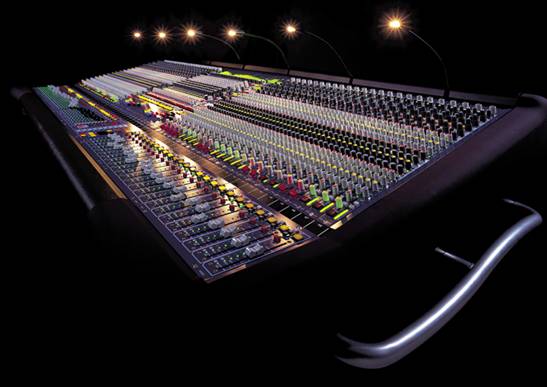
Processing racks at the FOH position at an outdoor concert.
Power amplifiers
Power amplifiers boost a low-voltage level signal and provide electrical power to drive a loudspeaker. All speakers require power amplification of the low-level signal by an amplifier, including headphones. Most professional audio amplifiers also provide protection from overdriven signals, short circuits across the output, and excess temperature. A limiter is often used to protect loudspeakers and amplifiers from overload.
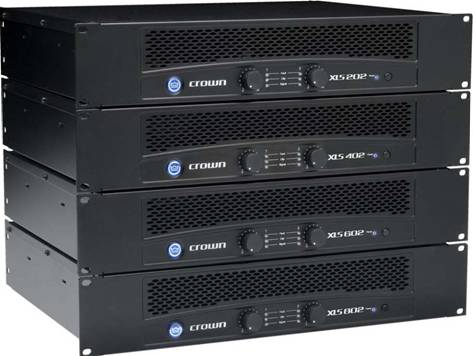
Like most sound reinforcement equipment products, professional amplifiers are designed to be mounted within standard 19-inch racks. Many power amplifiers feature internal fans to draw air across their heat sinks. Since they can generate a significant amount of heat, thermal dissipation is an important factor for operators to consider when mounting amplifiers into equipment racks.[12] Active loudspeakers feature internally mounted amplifiers that have been selected by the manufacturer to be the best amplifier for use with the given loudspeaker.
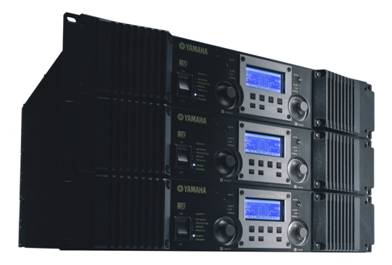
In the 1970s and 1980s, most PA amplifiers were heavy Class AB amplifiers. In the late 1990s power amplifiers in PA applications have became lighter, smaller, more powerful and more efficient due to increasing use of switching power supplies and Class D amplifiers, which offer significant weight and space savings as well as increased efficiency. Installations in railroad stations, stadia and airports, their high efficiency allow them to run with minimal additional cooling and with higher rack densities compared to older amplifiers.
Digital loudspeaker management systems (DLMS) that combine digital crossover functions, compression, limiting, and other features in a single unit have become popular since their introduction. They are used to process the mix from the mixing console and route it to the various amplifiers in use. Systems may include several loudspeakers, each with its own output optimized for a specific range of frequencies (i.e. bass, midrange and treble). Bi, tri, or quad amplifying a sound reinforcement system with the aide of a DLMS results in a more efficient use of amplifier power by sending each amplifier only the frequencies appropriate for its respective loudspeaker. Most DLMS units that are designed for use by non-professionals have calibration and testing functions such as a pink noise generator coupled with a real-time analyzer to allow automated room equalization.
The amount of amplifier power used in a performance setting depends on a number of factors, such as the desired Sound Pressure Level of the performers, whether the venue is indoors or outdoors, and the presence of competing background noise. The following list gives a rough “rule of thumb” for the amount of amplifier power used in different settings:
Output transducers
Main loudspeakers
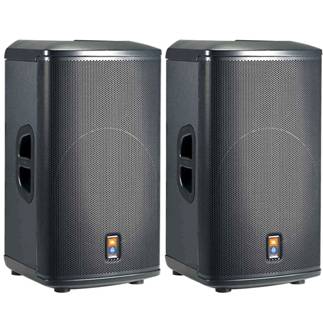
A large line array with separate subs and a smaller side fill line array.
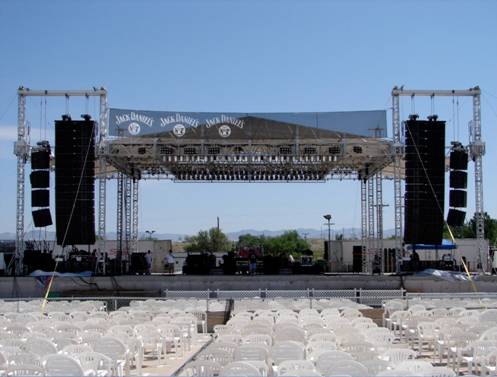
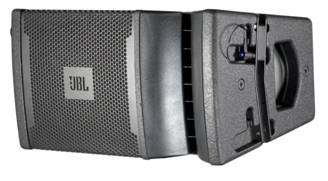
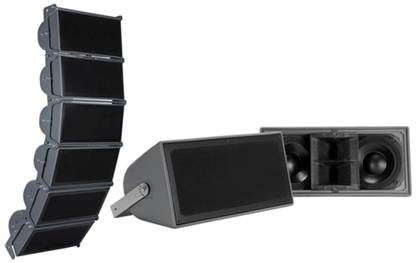
simple and inexpensive PA loudspeaker may have a single full-range loudspeaker driver, housed in a suitable enclosure. More elaborate, professional-caliber sound reinforcement loudspeakers may incorporate separate drivers to produce low, middle, and high frequency sounds. A crossover network routes the different frequencies to the appropriate drivers. In the 1960s, horn loaded theater loudspeakers and PA speakers were almost always “columns” of multiple drivers mounted in a vertical line within a tall enclosure. The 1970s to early 1980s was a period of innovation in loudspeaker design with many sound reinforcement companies designing their own speakers. The basic designs were based on commonly known designs and the speaker components were commercial speakers. The areas of innovation were in cabinet design, durability, ease of packing and transport, and ease of setup. This period also saw the introduction of the hanging or “flying” of main loudspeakers at large concerts. During the 1980s the large speaker manufactures started producing standard products using the innovations of the 1970s. These were mostly smaller two way systems with 12″, 15″ or double 15″ woofers and a high frequency driver attached to a high frequency horn. The 1980s also saw the start of loudspeaker companies focused on the sound reinforcement market. The 1990s saw the introduction of Line arrays, where long vertical arrays of loudspeakers with a smaller cabinet are used to increase efficiency and provide even dispersion and frequency response. This period also saw the introduction of inexpensive molded plastic speaker enclosures mounted on tripod stands. Many feature built-in power amplifiers which made them practical for non-professionals to set up and operate successfully. The sound quality available from these simple ‘powered speakers’ varies widely depending on the implementation.

The three different
types of transducers are subwoofers, compression drivers, and tweeters. They all feature the combination of a voicecoil magnet, cone or diaphragm, and a frame or structure. Loudspeakers have a power rating (in watts) which indicates their maximum power capacity, to help users avoid overpowering them. Thanks to the efforts of the Audio Engineering Society (AES) and the loudspeaker industry group ALMA, power-handling specifications became more trustworthy, although adoption of the EIA-426-B standard is far from universal. Around the mid 1990s trapezoidal-shaped enclosures became popular as this shape allowed many of them to be easily arrayed together.
A number of companies are now making lightweight, portable speaker systems for small venues that route the low-frequency parts of the music (electric bass, bass drum, etc.) to a powered subwoofer. Routing the low-frequency energy to a separate amplifier and subwoofer can substantially improve the bass-response of the system. Also, clarity may be enhanced, because low-frequency sounds take a great deal of power to amplify; with only a single amplifier for the entire sound spectrum, the power-hungry low-frequency sounds can take a disproportionate amount of the sound system’s power.
Professional sound reinforcement speaker systems often include dedicated hardware for “flying” them above the stage area, to provide more even sound coverage and to maximize sight lines within performance venues.
The number of speaker enclosures used in a performance varies a great deal, but the following list gives a rough idea of how many cabinets are used in a typical venue:
- “Small Vocal” system – Two full range speakers mounted on tripod stands.
- “Large Vocal” system – Four full-range speakers for wide-area coverage.
- “Small Club” system – Two subwoofers and two mid/high speakers.
- “Large Club” system – Four subwoofers and four mid/high speakers.
- “Small Stadium” system – Four subwoofers, four mid-bass speakers, and four mid/high speakers.[13]
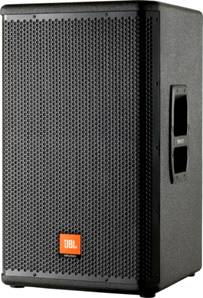
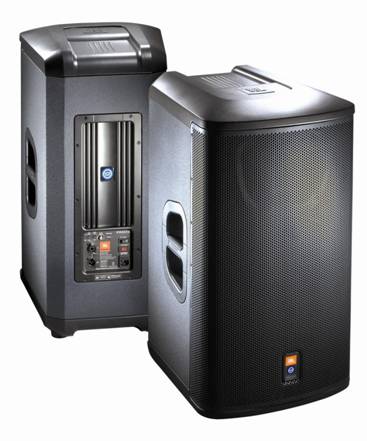
Monitor loudspeakers
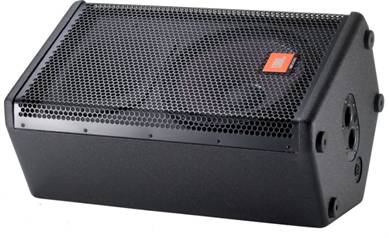
Monitor loudspeakers, also called ‘foldback’ loudspeakers, are speaker cabinets which are used onstage to help performers to hear their singing or playing. As such, monitor speakers are pointed towards a performer or a section of the stage. They are generally sent a different mix of vocals or instruments than the mix that is sent to the main loudspeaker system. Monitor loudspeaker cabinets are often a wedge shape, directing their output upwards towards the performer when set on the floor of the stage. Two-way, dual driver designs are common as monitor loudspeakers need to be smaller to save space on the stage. These loudspeakers typically require less power and volume than the main loudspeaker system, as they only need to provide sound for a few people who are in relatively close proximity to the loudspeaker. Some manufacturers have designed loudspeakers for use either as a component of a small PA system or as a monitor loudspeaker.
Using monitor speakers instead of in ear monitors typically results in an increase of stage volume, which can lead to more feedback issues and progressive hearing damage for the performers in front of them.[14] The clarity of the mix for the performer on stage is also typically not as clear as they hear more extraneous noise from around them. The use of monitor loudspeakers, active or passive, requires more cabling and gear on stage, resulting in an even more cluttered stage. These factors, amongst others, have led to the increasing popularity of in- ear monitors.
In-Ear Monitors
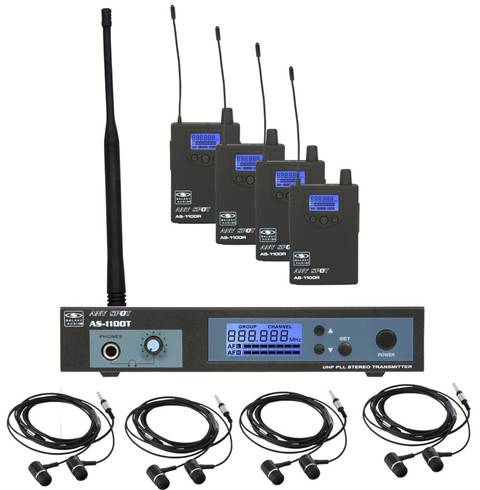
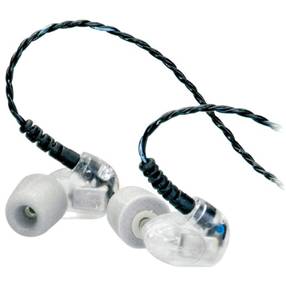
A pair of universal fit in-ear monitors. This particular model is the Etymotic ER-4S
In-ear monitors are headphones that have been designed for use as monitors by a live performer. They are either of a “universal fit” or “custom fit” design. The universal fit in ear monitors feature rubber or foam tips that can be inserted into virtually anybody’s ear. Custom fit in ear monitors are created from an impression of the users ear that has been made by an audiologist. In-ear monitors are almost always used in conjunction with a wireless transmitting system, allowing the performer to freely move about the stage whilst maintaining their monitor mix.
In-ear monitors offer considerable isolation for the performer using them, meaning that the monitor engineer can craft a much more accurate and clear mix for the performer. A downside of this isolation is that the performer cannot hear the crowd or other performers on stage that do not have microphones. This has been remedied by larger productions by setting up a pair of microphones on each side of the stage facing the audience that are mixed into the in-ear monitor sends.[14]
Since their introduction in the mid-1980s, in-ear monitors have grown to be the most popular monitoring choice for large touring acts. The reduction or elimination of loudspeakers other than instrument amplifiers on stage has allowed for cleaner and less problematic mixing situations for both the front of house and monitor engineers. Feedback is easier to manage and there is less sound reflecting off the back wall of the stage out into the audience, which affects the clarity of the mix the front of house engineer is attempting to create.
